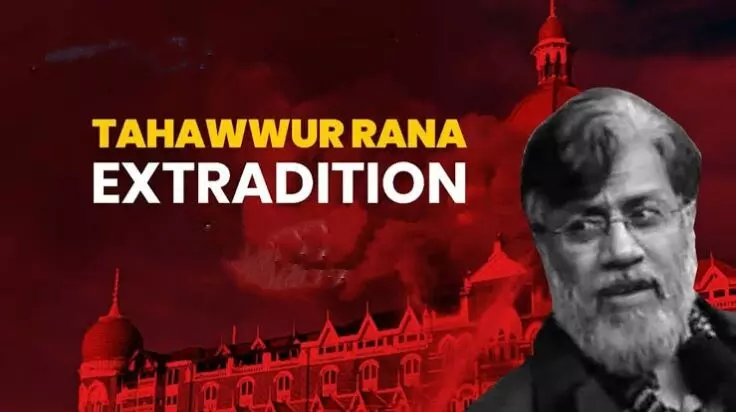Congress accuses Modi government of taking false credit for Tahawwur Rana, reveals ‘true’ story

The Congress today decried the Modi government’s effort to take credit for extradition of Tahawwur Hussain Rana, one of the key accused in the 26/11 Mumbai terror attacks, revealing the behind the scene story the long drawn process involved for bringing him to Indian shores.
Former Union Home Minister P Chidambaram in the UPA government said today that Rana was extradited to India today on April 10, 2025, but the full story deserves to be known and told to inform people.
In a written statement, Chidambaram said that while the Modi government is rushing to take credit for this development, the truth is far from their spin. This extradition is the culmination of a decade-and-a-half of painstaking diplomatic, legal and intelligence efforts which were initiated, led, and sustained by the UPA government in close coordination with the United States, he pointed out.
The coursework began on November 11, 2009, when the NIA registered a case in New Delhi against David Coleman Headley (US citizen), Tahawwur Rana (Canadian citizen), and others involved in the 26/11 conspiracy, the former Home Minister underlined.
That very month, Canada’s Foreign Minister confirmed collaboration with Indian agencies, thanks to UPA’s effective foreign policy, Chidambaram said adding that the FBI had arrested Rana in Chicago in 2009 for supporting a failed LeT plot in Copenhagen.
Even though Rana was acquitted by a US court of direct involvement in the 26/11 attack in June 2011, he was convicted for other terrorism-related offences and sentenced to 14 years in prison. The UPA government publicly expressed its disappointment over his acquittal and kept diplomatic pressure alive, he said.
Despite legal setbacks, the UPA government persisted through institutional diplomacy and legal mechanisms. A three-member NIA team interrogated Headley in the US before the end of 2011, based on mutual legal cooperation frameworks under the MLAT, the Congress leader said.
The US government transferred crucial evidence to India, which became part of the NIA’s chargesheet filed in December 2011 against nine accused, including Rana. The Special NIA Court in Delhi issued non-bailable warrants, and Interpol Red Notices were secured for absconding accused, Chidambaram pointed out.
Emphasizing, the former Home Minister said this was not a media stunt but quiet, determined legal diplomacy. In 2012, External Affairs Minister Salman Khurshid and Foreign Secretary Ranjan Mathai took up the matter of Headley’s and Rana’s extradition with US Secretary of State Hillary Clinton and Under Secretary Wendy Sherman. By January 2013, Headley was sentenced to 35 years, and Rana’s sentencing in the US also took place. India’s demand for Headley’s extradition was reiterated firmly, even as the UPA government expressed its disappointment at the sentence, Chidambaram said putting the record straight.
Then Ambassador to the US Nirupama Rao also pursued the matter consistently. This was a textbook example of how sensitive issues of international justice should be handled through diplomacy, he said.
Even after the change in government in 2014, it was the institutional efforts already in motion that kept the case alive. In 2015, Headley agreed to turn approver in the 26/11 case. In 2016, a Mumbai court pardoned him on the condition of full cooperation, which helped the case against Zabiuddin Ansari (Abu Jundal), the statement said.
A team visited the US in December 2018 to resolve legal hurdles and again in January 2019 was told that Rana must serve his full sentence in the US. His release date was set for 2023, accounting for time served. These are not “strong leader” moments, but are the slow wheels of justice, pushed forward by years of hard work, Chidambaram took pains to elaborate.
In June 2020, after Rana was released on health grounds, the Indian government requested his arrest. The Biden administration supported his extradition. In May 2023, a US court certified his extraditability under the US-India Extradition Treaty. Rana appealed and filed multiple petitions including a habeas corpus and, finally, a writ to the US Supreme Court citing double jeopardy. All were rejected. The final denial came on January 21, 2025, a day after Donald Trump’s inauguration, he said.
In February 2025, Prime Minister Modi and President Trump stood at a press conference and tried to take credit for what was essentially the result of years of UPA-era groundwork. By February 17, Indian officials confirmed Rana’s role in the 26/11 conspiracy, dating back to 2005, when he coordinated with LeT and ISI operatives. Finally, on April 8, 2025, US authorities handed over Rana to Indian officials. He arrived in New Delhi on April 10.
Let the facts be clear: the Modi government did not initiate this process, nor did it secure any new breakthrough. It merely benefited from the mature, consistent, and strategic diplomacy begun under the UPA. This extradition is not the result of any grandstanding, it is a testament to what the Indian state can achieve when diplomacy, law enforcement, and international cooperation are pursued sincerely and without any kind of chest-thumping, the statement concluded putting facts in public domain.
